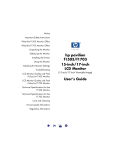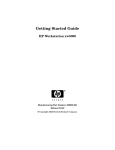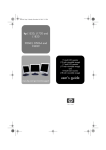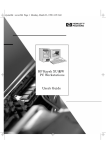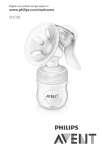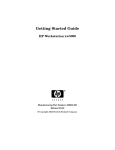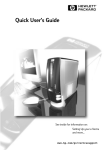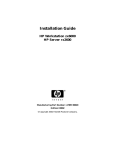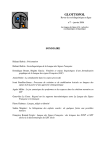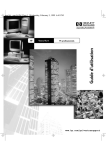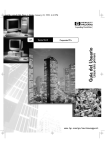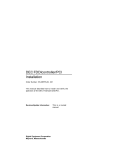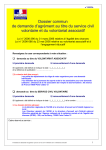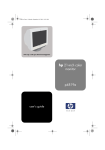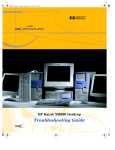Download HP NetVectra N20 User's Manual
Transcript
drac-usr.bk : drac-fc.fb4 Page i Friday, April 30, 1999 3:48 PM * drac-usr.bk : notice.fb4 Page ii Friday, April 30, 1999 3:48 PM Notice The information contained in this document is subject to change without notice. Hewlett-Packard makes no warranty of any kind with regard to this material, including, but not limited to, the implied warranties of merchantability and fitness for a particular purpose. Hewlett-Packard shall not be liable for errors contained herein or for incidental or consequential damages in connection with the furnishing, performance, or use of this material. This document contains proprietary information that is protected by copyright. All rights are reserved. No part of this document may be photocopied, reproduced, or translated to another language without the prior written consent of Hewlett-Packard Company. AdobeTM and AcrobatTM are trademarks of Adobe Systems Incorporated. Microsoft®, MS®, MS-DOS®, Windows® and Windows® NT are U.S. registered trademarks of Microsoft Corporation. Hewlett-Packard France Thin Client Operation 38053 Grenoble Cedex 9 France 1999 Hewlett-Packard Company drac-usr.bk : title.fb4 Page iii Friday, April 30, 1999 3:48 PM User’s Guide drac-usr.bk : title.fb4 Page iv Friday, April 30, 1999 3:48 PM Important Safety Information Who this Manual is For This manual is for anyone who wants to: • • • Set up the PC for the first time Troubleshoot problems on the PC Find out where to get more information and support. Important Ergonomic Information It is strongly recommended that you read the ergonomic information before using your PC. Refer to see “Working in Comfort” on page 11 for more information. Important Safety Information WARNING If you have any doubt that you can lift the PC or display safely, do not try to move it without help. For your safety, never remove the PC’s cover without first removing the power cord from the power outlet, and any connection to a telecommunications network. Always replace the cover on the PC before switching it on again. To avoid electric shock, do not open the power supply. There are no user serviceable parts inside. iv English drac-usr.bk : title.fb4 Page v Friday, April 30, 1999 3:48 PM Important Safety Information WARNING There is a danger of explosion if the battery is incorrectly installed. For your safety, never attempt to recharge, disassemble, or burn the old battery. Replace only with the same or equivalent type recommended by the manufacturer. The battery in this PC is a lithium battery which does not contain heavy metals. Nevertheless, in order to protect the environment, do not dispose of batteries in household waste. Please return used batteries to the shop from which you bought them, or to the dealer from whom you purchased your PC, or to HP, so that they can either be recycled or disposed of in a sound way. Returned used batteries will be accepted free of charge. To avoid electric shock and harm to your eyes by laser light, do not open the laser module. The laser module should be serviced by service personnel only. Do not attempt to make any adjustment to the laser unit. Refer to the label on the CD-ROM for power requirements and wavelength. This product is a class I laser product. Do not attempt to connect this product to the phone line during a lightning storm. Never install telephone jacks in wet locations unless the telephone line has been disconnected at the network interface. Never touch uninsulated telephone wires or terminals unless the telephone line has been disconnected at the network interface. Use caution when installing or modifying telephone lines. Avoid using a telephone (other than a cordless type) during a lightning storm. There may be a risk from lightning. Do not use the telephone to report a gas leak in the vicinity of the leak. Never touch or remove the Communications board without first removing the connection to the telephone network. English v drac-usr.bk : title.fb4 Page vi Friday, April 30, 1999 3:48 PM Important Safety Information vi English drac-usr.bk : drac.fb4 Page 1 Friday, April 30, 1999 3:48 PM 1 Hard Disk Activity LED LAN Activity LED Optional Floppy Disk Drive Power On Status Light Power On/Off Button Optional CD-ROM Drive Setting Up and Using Your PC drac-usr.bk : drac.fb4 Page 2 Friday, April 30, 1999 3:48 PM 1 Setting Up and Using Your PC Unpacking Your PC Unpacking Your PC 2 English drac-usr.bk : drac.fb4 Page 3 Friday, April 30, 1999 3:48 PM 1 Setting Up and Using Your PC Mounting Your PC Mounting Your PC You can use your PC as a desktop, with a foot stand (optional) or with an underdesk socket (optional). Attaching the Foot Stand Attaching the Underdesk Socket 3 2 1 4 English 3 drac-usr.bk : drac.fb4 Page 4 Friday, April 30, 1999 3:48 PM 1 Setting Up and Using Your PC Connecting Your PC Accessories Connecting Your PC Accessories WARNING Always turn the volume down before connecting headphones or speakers, to avoid discomfort from unexpected noise or static. Listening to loud sounds for prolonged periods of time may permanently damage your hearing. Before putting on headphones, place them around your neck and turn the volume down. When you put on the headphones, slowly increase the volume until you find a comfortable listening level. When you hear comfortably and clearly, without distortion, leave the volume control in that position. Line Out/ Headphone Connector (microphone connector, some models only) Line In Connector Microphone connector (line out/ headphone connector, some models only) USB Connectors Mouse Serial Connector 1 RJ-45 UTP (Unshielded Twisted Pair) 10/100BT Lan Connector Keyboard Monitor Serial Connector 2 NOTE Parallel Connector Your PC BootROM supports PXE (Preboot Execution Environment). This protocol is enabled by selecting Start from Network/Boot from LAN in your PC’s Setup program, accessed by pressing Del or F2 at Start-up. 4 English drac-usr.bk : drac.fb4 Page 5 Friday, April 30, 1999 3:48 PM 1 Setting Up and Using Your PC Connecting the Power Cables Connecting the Power Cables WARNING For your safety always connect the equipment to a grounded wall outlet. Always use a power cord with a properly grounded plug, such as one provided with this equipment, or one in compliance with your national safety standards. This equipment is disconnected from the power by removing the power cord from the power outlet. This means that the equipment must be located to a power outlet that is easily accessible. 1 CAUTION Remove the warning label covering the PC’s connector, and ensure that the voltage is correct for your country (The voltage is set during manufacture and should already be correct). Starting your PC on the wrong voltage setting may cause it permanent damage. 1 Voltage Selection Switch 2 3 4 NOTE If you have a CD-ROM drive, carefully remove the cardboard insert from the drive before starting your PC. English 5 drac-usr.bk : drac.fb4 Page 6 Friday, April 30, 1999 3:48 PM 1 Setting Up and Using Your PC Starting Your PC for the First Time Starting Your PC for the First Time Your PC has preinstalled software. With some models, this will require initialization the first time you start the PC. This process sets up the software in your language and sets up your software to use the hardware installed in your computer (you can change the settings after the software has been initialized). NOTE Do NOT switch OFF the PC while the software is being initialized- this could cause unexpected results. Stopping Your PC To stop the PC, first make sure that you have exited all applications and then use your operating system’s shutdown command in the Start menu. Using Power Management Power management enables you to reduce the PC’s power consumption when you are not using the PC. HP Setup Program You can configure power management in the HP Setup program. Refer to “Power Menu Items” in the HP Setup program. (To enter the PC’s Setup program, restart the PC and press Del or F2 during start-up.) Operating System Power Refer to your operating system documentation for information about the power management features provided. Management EPA and Energy Star® Compliancy As an Energy Star® partner, HP has determined that this product meets the Energy Star® guidelines for energy efficiency. Additional Information and Help Additional information about your PC is available on HP’s web site at www.hp.com/go/thinclientsupport. 6 English drac-usr.bk : drac2.fb4 Page 7 Friday, April 30, 1999 3:48 PM 2 Troubleshooting Your PC This chapter can help you solve problems that you may encounter when using your PC. drac-usr.bk : drac2.fb4 Page 8 Friday, April 30, 1999 3:48 PM 2 Troubleshooting Your PC If Your PC Does Not Start Properly If Your PC Does Not Start Properly If your display is blank and there are no error messages when you turn on your PC, follow this procedure: 1 Check that your PC and monitor are plugged in and turned on. (The power light should be illuminated.) 2 Make sure that all cables and power cords are firmly plugged in. 3 Make sure the power outlet is working. 4 Check that you have removed the cardboard from the CD-ROM drive. (Refer to page 5) 5 Check that the monitor’s brightness and contrast controls are properly set. 6 Ensure that you have entered the correct password, if one is required to use this PC. 7 Switch off the monitor, and unplug it from the power outlet. Disconnect the video cable and examine the video cable connector pins. If the pins are bent, carefully straighten them. 8 Check your monitor’s manual to find out which refresh rates are supported. Use your operating system’s Display Control Panel to select the correct refresh rate. If the problem continues, contact the people in your organization who support and maintain the PCs on your network. Monitor Problems If the display image is not aligned with the screen, use the controls on your monitor to center the image (refer to your monitor’s manual for instructions). 8 English drac-usr.bk : drac2.fb4 Page 9 Friday, April 30, 1999 3:48 PM 2 Troubleshooting Your PC If Your PC Does Not Start Properly If Your Keyboard Does Not Work 1 Ensure that the keyboard is correctly connected to the PC. 2 Ensure that no keys are stuck on the keyboard. 3 Ensure that no liquids have been spilled on the keyboard. 4 If you turn on your PC, the operating system boots, the keyboard is correctly connected and does not work, the power-on password may be set to “keyboard locked”. You will need to enter a password to unlock the keyboard (and mouse). If your Mouse Does Not Work 1 Ensure that the mouse is correctly connected to the PC. 2 Ensure the mouse driver supplied with the preloaded software is installed correctly. 3 Clean the mouse ball and rollers. English 9 drac-usr.bk : drac2.fb4 Page 10 Friday, April 30, 1999 3:48 PM 2 Troubleshooting Your PC HP Setup Program HP Setup Program To check the PC’s configuration: First, Turn Off Your PC Turn on the monitor and then the PC. If the PC is already turned on, save your data and exit all programs. For Windows NT 4.0 , Windows 95 and Windows 98, use the Shut Down command. To Go to the HP Summary While the Hewlett Packard logo appears on your display, press Tab or Del. This will take you to the HP Summary Screen (POST screen). The Screen Summary Screen will appear for only a short time. To retain the screen indefinitely (until you decide to leave it), press Pause/Break. To Go to the Setup Program To go immediately into the Setup program while the Hewlett Packard logo appears on your monitor (and bypass the Summary Screen), press Del or F2. Hewlett Packard Support and Information Services Hewlett Packard computers are engineered for quality and reliability to give you many years of trouble-free service. To ensure that your PC system maintains its reliability and to keep you up-to-date with the latest developments, HP and a worldwide network of trained and authorized resellers provide a comprehensive range of service and support options. You can download documentation in PDF (Adobe Acrobat) format for your PC at HP’s web site: www.hp.com/go/thinclientsupport 10 English drac-usr.bk : wic-chap.fb4 Page 11 Friday, April 30, 1999 3:48 PM 3 Working in Comfort Thank you for selecting HP computing equipment. To optimize your comfort and productivity, it is important that you set up your work area correctly and use your HP equipment properly. With that in mind, we have developed some set-up and use recommendations for you to follow based on established ergonomic principles. drac-usr.bk : wic-chap.fb4 Page 12 Friday, April 30, 1999 3:48 PM 3 Working in Comfort Improper and prolonged use of keyboards and input devices are among those tasks that have been associated with repetitive strain injury (RSI) to soft tissues in the hands and arms. If you experience discomfort or pain while using any computing equipment, discontinue use immediately and consult your physician as soon as possible. In addition to the information on RSI given in this chapter, you may also consult the online version of Working in Comfort preloaded on the hard disk of the your HP computing equipment, or visit HP’s Working in Comfort web site at: www.hp.com/ergo. About Repetitive Strain Because your comfort and safety are our primary concern, we strongly recommend that you use HP computing equipment in accordance with Injury established ergonomic principles and recommendations. Scientific literature suggests that there may be a relationship between injury to soft tissues— especially in the hands and arms—and prolonged improper use of keyboards or other equipment requiring repeated motions of the hands and forearms. This literature also suggests that there are many other risk factors that may increase the chance of such injury, commonly called Repetitive Strain Injury. What is RSI? Repetitive Strain Injury (RSI—also known as cumulative trauma disorder or repetitive motion injury) is a type of injury where soft tissues in the body, such as muscles, nerves, or tendons, become irritated or inflamed. RSI has been a reported problem for those who perform repetitive tasks such as assembly line work, meatpacking, sewing, playing musical instruments, and computer work. RSI also has been observed in those who frequently engage in activities such as carpentry, knitting, housework, gardening, tennis, windsurfing and lifting children. What causes RSI? The specific causes of RSI have not been established. Nevertheless, the incidence of RSI has been associated with a variety of risk factors, including: • Too many uninterrupted repetitions of an activity or motion. • Performing an activity in an awkward or unnatural posture. • Maintaining static posture for prolonged periods. • Failing to take frequent short breaks. • Other environmental and psychosocial factors. In addition, there have been reports associating the occurrence of RSI with the use of computer keyboards, mice, and other input devices. Also, certain medical conditions, such as rheumatoid arthritis, obesity and diabetes, may predispose some people to this type of injury. 12 English drac-usr.bk : wic-chap.fb4 Page 13 Friday, April 30, 1999 3:48 PM 3 Working in Comfort What can I do to avoid RSI? Some people who use computers may experience physical discomfort during their use. This discomfort may be a symptom of a repetitive strain injury. Properly setting up and using computing equipment can help to minimize your chances of experiencing this discomfort. Well-designed and properly adjusted equipment alone may not be sufficient to eliminate all potential problems. Maintaining good posture and positioning when working on computers also has a significant bearing on your comfort. What if I experience discomfort? If you are experiencing any discomfort, seek professional medical advice immediately. Typically, the earlier a problem is diagnosed and treated, the easier it is to resolve. Preparing Your Work Environment When using HP computing equipment, it is important that your work environment contribute to your comfort and productivity. Your Chair It's very important that your chair provides a comfortable sitting position and offers the following features: • A stable base, such as five legs with casters. Make sure the casters are designed for the type of floor you have in your workspace, whether it is bare or carpeted. • A height- and tilt-adjustment feature. It should be easy to adjust your chair height from 40 cm to 52 cm (15.5 inches to 20.5 inches) as measured from the top of the seat pan to the floor. If you are much taller or shorter than average, you may need a chair that can be adjusted beyond this range. Adjust your chair so that the work surface or keyboard tray is at elbow height and your feet are flat on the floor with your knees slightly bent below your hips. Ideally, the seat pan should be able to tilt both forward (minimum of 5 degrees) and backward (minimum of 10 degrees). If the chair has an adjustable seat pan, inclining the seat slightly forward will transfer some of the pressure from the spine to the thighs and feet. This will relieve pressure on your back. • A curved seat edge. The front of the seat should be curved and finished in a “waterfall” edge. • An adjustable back support in both height and forward and backward tilt. It is important that the backrest correctly supports the lower part, or lumbar curve, of the back. • A freely rotating swivel so you can move easily from side-to-side. • Fully adjustable and padded armrests. The chair arms should not interfere with adjusting the chair or moving it close to your work surface. English 13 drac-usr.bk : wic-chap.fb4 Page 14 Friday, April 30, 1999 3:48 PM 3 Working in Comfort Seat Back Tilt Seat Back Height Seat Pan Tilt 5°-10° Seat Pan Height 40-52 cm Your Work Surface Ideally, you should be able to adjust the height of your work surface. A simple way to ensure your work surface is at the correct height is to first adjust the height of the seat-pan of your chair. With your chair properly adjusted and your feet firmly on the floor, adjust the work surface height until your forearms are parallel to the floor when you have your fingers on the keyboard or other input device. Your Work Posture Sitting in one position for long periods can be uncomfortable. To minimize the potential for physical discomfort or injury, it's important that you maintain proper posture. • Back - While sitting at your work surface, make sure your back is supported by the chair's backrest in an erect position or angled slightly backwards. • Arms - Your arms should be relaxed and loose, elbows close to your sides, with forearms and hands approximately parallel to the floor. • Wrists - Your wrists should be as straight as possible while using the keyboard, mouse or trackball. They should not be bent sideways, or more than 10 degrees up or down. 14 English drac-usr.bk : wic-chap.fb4 Page 15 Friday, April 30, 1999 3:48 PM 3 Working in Comfort • Legs - Your thighs should be horizontal or angled slightly downward. Your lower legs should be near a right angle to your thighs. Your feet should rest flat on the floor. If necessary, use a footrest, but double check that you have your seat height adjusted correctly before getting a footrest. • Head - Your head should be upright or tilted slightly forward. Avoid working with your head or trunk twisted. • Overall - Change your position frequently and take regular breaks to avoid fatigue. Setting Up Your HP Make sure that all the elements of your HP computer system—monitor, Computing Equipment document holder, keyboard, mice and other input devices, and headphones and speakers—are optimally arranged and adjusted to meet your personal requirements. The recommendations that follow will help you achieve this. Your HP Monitor It is important that your monitor screen be clean and positioned correctly to improve readability and help you work comfortably. Glare, high contrast, reflections, dirt and dust will interfere with what you see on the screen. The recommendations that follow can help you achieve a comfortable arrangement. • The top of your monitor screen should be at or slightly below eye level. Most HP monitors come with a tilt-and-swivel feature that makes it easy to adjust the screen position. • To avoid obscuring your view, the screen should be positioned perpendicular to your line of sight; that is, straight on. • To avoid glare or reflection, try to position the monitor so the screen is at a right angle to your window rather than in front of it. If reflection or glare persists, tilting the screen forward may help. English 15 drac-usr.bk : wic-chap.fb4 Page 16 Friday, April 30, 1999 3:48 PM 3 Working in Comfort Monitor Use Specifications • Maintain a comfortable viewing distance to the screen. Most people prefer a viewing distance of approximately 46 to 76 cm (18 to 30 inches), depending on monitor size. Character size and the amount of space available on the work surface can affect this distance. • Text should be easy to read. To help ease eyestrain, adjust text attributes such as character size, spacing, and color. In addition, you will need to use the controls provided with your monitor to adjust the visual settings so that contrast and brightness levels are comfortable for you. High contrast and low brightness is usually the preferable combination. • The monitor should be free from flicker. If the image on your screen is not stable, the monitor may require repair or adjustment. • When possible, use a program that has a simple user interface, such as easily identifiable icons and pull-down menus. Also, screen information should be displayed in a structured and well-organized way. • When viewing your monitor, your head should not be tilted more than 15 degrees forward. • You should not have to look up more than 5 degrees above horizontal or down more than 30 degrees below horizontal for normal work tasks, such as typing or reading. 16 English drac-usr.bk : wic-chap.fb4 Page 17 Friday, April 30, 1999 3:48 PM 3 Working in Comfort Document Holders When keying in data from a hard-copy document, placing it in a document holder rather than on a flat surface will make it easier to read. The following recommendations should be observed when using a document holder: • The document holder should be at approximately the same height and distance from your eyes as the screen, and as close to the monitor as possible to prevent neck twisting. Some users prefer a document holder mounted to the monitor while others prefer the document holder positioned between the screen and keyboard. • If the primary task is to view documents rather than using the monitor, the document holder may be placed directly in front of the keyboard with the monitor slightly to the side. • To help reduce stress on your neck and prevent eye fatigue, try to minimize the movement of your head and eyes while using a document holder. Your HP Keyboard Keyboard Slope Thigh Clearance ≥ 6 cm Keyboard Height 64-76 cm The proper positioning and use of your HP keyboard is important when using HP computing equipment. Be sure to observe the following recommendations to optimize your comfort and safety: • We recommend you place your keyboard in front of the screen or document holder, whichever is viewed the most. Your HP keyboard has long cables so you can place it in the position that is most comfortable for you while you are using your system. • Because HP keyboards vary in depth, you'll want to be sure that your work surface or keyboard tray has sufficient room to accommodate your model. The keyboard tray should be wide enough to hold both the keyboard and mouse or trackball: 66 to 71 cm (26 to 28 inches). English 17 drac-usr.bk : wic-chap.fb4 Page 18 Friday, April 30, 1999 3:48 PM 3 Working in Comfort • Your HP keyboard may have a kickstand that can be opened or closed to raise or lower the keyboard angle. If you are in the correct sitting position with your elbows at about the same level as the work surface, you may not need to use it. However, if your elbows are below the work surface, you may wish to use the kickstand to raise the back of the keyboard. • An adjustable keyboard tray may be useful if you cannot adjust your chair or work surface to the proper height for typing. It should adjust in height from 64 to 76 cm (25 to 30 inches) above the floor and tilt forward and backward to help you find the most comfortable position. Note that research has shown that there may be less muscle tension in shoulders and forearms with the keyboard tilted away from you. • When using your HP keyboard, remember it takes very little pressure or force from your fingers to activate the keys. Improper typing style—the use of too much force—can place unnecessary stress on the tendons and muscles in your hands, wrists, and forearms. • Make sure that your hands are in a neutral position when you use your keyboard. This means that your forearms, wrists, and hands should be in a straight line. • The keyboard has a low profile to help prevent excessive bending of your wrists while typing. Literature suggests that you should not bend your wrists sideways or more than 10 degrees up or down. Keep your wrists straight by moving your entire hand and forearm over to use the function keys or numeric keypad. • You may use a palm rest to help keep your hands and wrists in a comfortable and neutral position when you are not typing. Some HP keyboards come with an integrated palm rest. If you use a palm rest, see that it is rounded and padded, and flush in height with the front edge of the keyboard. Note that your palms—not your wrists—should rest on the palm rest. If you don't have a palm rest, try not to rest your wrists on a sharp edge, such as a work surface edge. Mice and Other Input Devices 18 English drac-usr.bk : wic-chap.fb4 Page 19 Friday, April 30, 1999 3:48 PM 3 Working in Comfort Various aspects of using mice and other input devices may increase your risk of discomfort or injury. Observing the following recommendations may reduce that risk: • As with the keyboard, try to keep your hand, wrist and forearm in a neutral position while using your mouse or other input device. • When using a stylus or light pen with a graphics tablet, don't grip the stylus tightly. Keep your hand and fingers relaxed and try to maintain a neutral posture in your hand, wrist and forearm. • If you use your thumb to rotate the ball on a trackball or spaceball, keep it in a relaxed, natural shape, and maintain a neutral posture in your hand, wrist and forearm. • Hold the mouse gently by draping your fingers over it. Keep your hand relaxed and fingers loose. Do not grip the mouse tightly. • It takes very little pressure or force from your fingers to activate the buttons or scroll wheel on your mouse, scrolling mouse, trackball or other input device. Using too much force can place unnecessary stress on the tendons and muscles in your hands, wrists and forearms. • If you are using a scrolling mouse, be sure to keep your fingers and hand in a relaxed, neutral position when activating the scroll wheel. Also, this type of mouse features software that can minimize the number of mouse movements or button clicks. • When using a mouse, trackball, stylus and graphics tablet, or other input device, position it as close to the keyboard as possible, and keep it at the same level so you do not have to stretch while using it. • Use a good quality mouse pad to enable the mouse to work most effectively and reduce unnecessary hand and wrist movements. • Be sure to keep your mouse and trackball clean. Regular removal of accumulated dust and dirt helps ensure proper tracking and reduces unnecessary hand and wrist motions. English 19 drac-usr.bk : wic-chap.fb4 Page 20 Friday, April 30, 1999 3:48 PM 3 Working in Comfort WARNING If your PC is multimedia or if you add a sound card to your PC, always turn the volume down before connecting headphones or speakers, to avoid discomfort from unexpected noise or static. Listening to loud sounds for prolonged periods of time may permanently damage your hearing. Before putting on headphones, place them around your neck and turn the volume down. When you put on the headphones, slowly increase the volume until you find a comfortable listening level. when you can hear comfortably and clearly, without distortion, leave the volume control in that position. Comfort and Safety Checklist These recommendations are drawn from the latest available international ergonomic standards and recommendations, including ISO 9241 and ANSI/HFS 100-1988. Document Holder Keyboard Slope Thigh Clearance ≥6 cm General Keyboard Height 64-76 cm • Work Surface Height - Adjust either your seat height, work surface or both, to position the work surface at approximately elbow height. • Work Surface Arrangement - Make sure frequently used equipment is within easy reach. For example, if you are primarily using the keyboard, place it directly in front of you, not to the side. If you are primarily using the mouse, place it in front of your hand or arm. If you are using both a mouse and keyboard, place them both at the same work surface height and close together. If a palm rest is used, the height should be flush with the front edge of the keyboard. Other items, such as your telephone or notepad, also should be considered. • Monitor - Place your monitor so that the top of the screen is at, or slightly below, eye level (up to 15 degrees). • Head - Do not tilt your head forward by more than 15 degrees, and try not to turn your head toward the side. 20 English drac-usr.bk : wic-chap.fb4 Page 21 Friday, April 30, 1999 3:48 PM 3 Working in Comfort Overall • Back - While sitting at your work surface, make sure your back is supported by the chair's backrest in an erect position or angled slightly backwards. • Arms - Make sure your arms and elbows are relaxed and loose, with your upper arm perpendicular to the floor or slightly forward. Keep your forearms and hands approximately parallel with the floor with elbows bent between 70 and 115 degrees. Keep your elbows close to your sides (less than 20 degrees away from your body). • Legs - Your thighs should be horizontal or angled slightly downward. Your lower legs should be near a right angle to your thighs. Make sure there is sufficient room under the work surface for your legs. • Feet - If after adjusting your chair you cannot rest your feet comfortably on the floor, use a footrest, preferably one that can be adjusted in height and angle. • Look away from the screen from time-to-time to help reduce eyestrain. Focus on distant objects briefly, and blink periodically to lubricate your eyes. You also should have your eyes checked on a regular basis and ensure your eyeglass prescription is suitable for working on a monitor screen. • Remember to occasionally shift position and move your body. Keeping your body in one position for long periods is unnatural and stressful. When prolonged work is required, take frequent short breaks. As a rule of thumb, a five or ten minute break every hour is a good idea. Short frequent breaks are more beneficial than longer less frequent breaks. Data show that people who work for long periods of time without a break may be more prone to injury. • Changing tasks frequently will help prevent muscle stiffness. Examples: alternating between keyboarding, reading, writing, filing, and moving around in your work environment, helps you maintain a relaxed posture. Occasionally stretch the muscles in your hands, arms, shoulders, neck and back. You should stretch at least as often as you take brief task breaks—at least once every hour. • Discomfort may be alleviated by using alternative ergonomic designs and accessories such as ergonomically personalized chairs, palm rests, keyboard trays, alternative input devices, prescription eyeglasses, antiglare screens, and more. Seek additional information from the sources available to you, including your employer, doctor, local office supply store, and the Information Sources listed in the online version of Working in Comfort, preloaded on the hard disk of your HP computing equipment. English 21 drac-usr.bk : wic-chap.fb4 Page 22 Friday, April 30, 1999 3:48 PM 3 Working in Comfort 22 English drac-usr.bk : bckmttr.fb4 Page 23 Friday, April 30, 1999 3:48 PM Regulatory Information, Software License Agreement and Software Warranty drac-usr.bk : bckmttr.fb4 Page 24 Friday, April 30, 1999 3:48 PM Regulatory Information DECLARATION OF CONFORMITY According to ISO/IEC Guide 22 and EN 45014 Manufacturer’s Name: HEWLETT-PACKARD France S.A.S Manufacturer’s Address: 5 Avenue Raymond Chanas 38320 Eybens, FRANCE Declares that the products: Product Name: Personal Computer Model Number: HP Small PC 20 HP NetPC 20 Conforms to the following Product Specifications SAFETY International: IEC 60950:1991 +A1+A2+A3+A4 / GB4943-1995 Europe: EN 60950:1992 +A1+A2+A3+A4 EMC CISPR 22:1993 / EN 55022:1994 Class B/ GB9254-1988 EN 50082-1:1992 IEC 801-2:1992 / prEN 55024-2:1992 - 4kV CD, 8kV AD IEC 801-3:1984 / prEN 55024-3:1991 - 3V/m IEC 801-4:1988 / prEN 55024-4:1992 -0.5 kV Signal Lines, 1 kV Power Lines IEC 555-2:1982+A1:1985 / EN60555-2:1987 IEC 1000-3-3:1994 / EN61000-3-3:1995 Supplementary information: the product herewith complies with the requirements of the EMC Directive 89/336/EEC and the Low Voltage Directive 73/23/EEC, both amended by the Directive 93/68/EEC and carries the CE marking accordingly. Grenoble 15 September 1998 24français français Jean-Marc JULIA Product Quality Manager drac-usr.bk : bckmttr.fb4 Page 25 Friday, April 30, 1999 3:48 PM DECLARATION OF CONFORMITY According to ISO/IEC Guide 22 and EN 45014 Manufacturer’s Name: HEWLETT-PACKARD France Manufacturer’s Address: 5 Avenue Raymond Chanas-Eybens 38053 Grenoble Cedex 09 - FRANCE Declares that the products: Product Name: Personal Computer Model Number: HP N-30 Conforms to the following Product Specifications SAFETY • International: IEC 60950:1991 +A1+A2+A3+A4 / GB4943-1995 • Europe: EN 60950:1992 +A1+A2+A3+A4 EMC • CISPR 22:1993 +A1+A2/ EN 55022:1994 +A1+A2 Class B 1) • EN 50082-1:1992 IEC 801-2:1992 / prEN 55024-2:1992 - 4kV CD, 8kV AD IEC 801-3:1984 / prEN 55024-3:1991 - 3V/m IEC 801-4:1988 / prEN 55024-4:1992 - 0.5 kV Signal Lines, 1 kV Power Lines • IEC 555-2:1982+A1:1985 / EN60555-2:1987 • IEC 1000-3-3:1994 / EN61000-3-3:1995 • GB9254-1988 • FCC Title 47 CFR, Part 15 Class B 2) • ICES-003, Issue 2 • VCCI-B • AS / NZ 3548:1992 Supplementary information: The product herewith complies with the requirements of the following Directives and carries the CE-marking accordingly: EMC directive 89/336/EEC and Low Voltage Directive 73/23/EEC, both amended by the Directive 93/68/EEC. 1) 2) The product was tested in a typical configuration with Hewlett-Packard Personal Computer Systems. This Device complies with Part 15 of the FCC Rules. Operation is subject to the following two conditions: (1) this device may not cause harmful interference, and (2) this device must accept any interference received, including interference that may cause undesired operation. Grenoble February 1999 Jean-Marc JULIA Quality Manager For Compliance Information ONLY, contact: USA Contact: Hewlett-Packard Company, Corporate Product Regulations Manager, 3000 Hanover Street, Palo Alto, CA 94304. (Phone: (415) 857-1501) français français25 drac-usr.bk : bckmttr.fb4 Page 26 Friday, April 30, 1999 3:48 PM FCC (for USA only) Federal Communications Commission Radio Frequency Interference Statement Warning: This equipment has been tested and found to comply with the limits for a Class B digital device, pursuant to Part 15 of the FCC Rules. These limits are designed to provide reasonable protection against harmful interference in a residential installation. This equipment generates, uses, and can radiate radio frequency energy and, if not installed and used in accordance with the instructions, may cause harmful interference to radio communications. However, there is no guarantee that interference will not occur in a particular installation. If this equipment does cause harmful interference to radio or television reception, which can be determined by turning the equipment off and on, the user is encouraged to correct the interference by one or more of the following measures: • reorient or relocate the receiving antenna • increase the separation between the equipment and the receiver • connect the equipment into an outlet on a circuit different from that to which the receiver is connected • consult the dealer or an experienced radio/TV technician for help. Hewlett-Packard’s FCC Compliance Tests were conducted with HP-supported peripheral devices and HP shielded cables, such as those you receive with your system. Changes or modifications not expressly approved by Hewlett-Packard could void the user’s authority to operate the equipment. Notice for Canada This Class B digital apparatus complies with Canadian ICES-003. Cet appareil numérique de la Class B est conforme à la norme NMB-003 du Canada. Safety Warning for the USA and Canada If the power cord is not supplied with the computer, select the proper power cord according to your local national electric code. USA: use a UL listed type SVT detachable power cord. Canada: use a CSA certified detachable power cord. For your safety, never remove the PC’s cover without first removing the power cord and any connection to a telecommunication network. Always replace the cover before switching on again. Si le cordon secteur n’est pas livré avec votre ordinateur, utiliser un cordon secteur en accord avec votre code electrique national. USA: utiliser un cordon secteur “UL listed”‚ de type SVT. Canada: utiliser un cordon secteur certifié CSA. Pour votre sécurité, ne jamais retirer le capot de l’ordinateur sans avoir préalablement débranché le cordon secteur et toute connection à un réseau de télecommunication. N’oubliez pas de replacer le capot avant de rebrancher le cordon secteur. Changing a battery There is a danger of explosion if the battery is incorrectly installed. For your safety, never attempt to recharge, disassemble or burn the old battery. Replace the battery only with the same or equivalent type recommended by the manufacturer. The battery in this PC is a lithium battery which does not contain heavy metals, nevertheless, in order to protect the environment, do not dispose of batteries in household waste. Please return used batteries to the shop from which you bought them, to the dealer from whom you purchased the PC, or to Hewlett Packard, so that they can either be recycled or disposed of in an environmentally sound way. Returned used batteries will be accepted free of charge. Changement de la pile Il y a danger d’explosion lorsque la pile n’est pas installeé correctement. Pour votre sécurité, ne jamais essayer de recharger, de démonter ou de brûler l’ancienne pile. Remplacer uniquement avec une pile du même type ou d’un type équivalent recommandé par HP. La pile de cet ordinateur est une pile au lithium qui ne contient pas de métaux lourds, néanmoins, afin de protéger l’environnement, il ne faut pas la jeter dans les ordures ménagères mais la rendre au magasin ou vous l’avez achetée, ou revendeur où vous avez achetéz l’ordinateur, ou à Hewlett Packard, pour qu’elle soit recyclée, ou stockée de manière qui ne nuit pas à l’environnement. Les piles usées seront acceptées gratuitement. Notice for the Netherlands Bij dit apparaat zijn batterijen geleverd. Wanneer deze leeg zijn, moet U ze niet weggooien maar inleveren als KCA. 26français français drac-usr.bk : bckmttr.fb4 Page 27 Friday, April 30, 1999 3:48 PM Hinweis für Deutschland: Geräuschemission Lärmangabe nach Maschinenlärmverordnung - 3 GSGV (Deutschland): LpA < 70 dB am Arbeitsplatz bei normalem Betrieb nach DIN 45635 T.19 (under normal use in the workplace, as per ISO 7779). Warnung Wenn die Batterie nicht korrekt eingebaut wird, besteht Explosionsgefahr. Zu ihrer eigenen Sicherheit sollten Sie nicht versuchen, die Batterie wiederaufzuladen, zu zerlegen oder die alte Batterie zu verbrennen. Tauschen Sie die Batterie nur gegen den gleichen oder ähnlichen Typ aus, der vom Hersteller empfohlen wird. Bei der in diesem PC intergrierten Batterie handelts sich um eine Lithium-Batterie, die keine Schwermetalle enthält. Batterien und Akkumulatoren gehören nicht in den Hausmüll. Sie verden vom Hersteller, Händler oder deren Beauftragten kostenlos zurückgenommen, um sie einer Verwertung bzw. Entsorgung zuzuführen. Notice for Japan This equipment is in the Class B category information technology equipment based on the rules of the Voluntary Control Council For Interference by Information Technology Equipment (VCCI). Although aimed for residential area operation, radio interference may be caused when used near a radio or TV receiver. Read the instructions for correct operation. Recycling Your PC HP has a strong commitment toward the environment. Your HP Personal Computer has been designed to respect the environment as much as possible. HP can also take your old PC back for recycling when it reaches the end of its useful life. HP has a product take-back program in several countries. The collected equipment is sent to one of HP’s recycling facilities in Europe or the USA. As many parts as possible are reused. The remainder is recycled. Special care is taken for batteries and other potentially toxic substances, which are reduced into non-harmful components through a special chemical process. If you require more details about HP’s product take-back program, contact your dealer or your nearest HP Sales Office. français français27 drac-usr.bk : bckmttr.fb4 Page 28 Friday, April 30, 1999 3:48 PM HP Software Product License Agreement and Software Product Limited Warranty Your HP NetVectra PC contains preinstalled software programs. Please read the Software License Agreement before proceeding. CAREFULLY READ THIS LICENSE AGREEMENT AND LIMITED WARRANTY STATEMENT BEFORE PROCEEDING TO OPERATE THIS EQUIPMENT. RIGHTS IN THE SOFTWARE ARE OFFERED ONLY ON THE CONDITION THAT THE CUSTOMER AGREES TO ALL TERMS AND CONDITIONS OF THE LICENSE AGREEMENT. PROCEEDING TO OPERATE THE EQUIPMENT INDICATES YOUR ACCEPTANCE OF THESE TERMS AND CONDITIONS. IF YOU DO NOT AGREE WITH THE TERMS OF THE LICENSE AGREEMENT, YOU MUST NOW EITHER REMOVE THE SOFTWARE FROM YOUR HARD DISK DRIVE AND DESTROY THE MASTER DISKETTES, OR RETURN THE COMPLETE COMPUTER AND SOFTWARE FOR A FULL REFUND. PROCEEDING WITH CONFIGURATION SIGNIFIES YOUR ACCEPTANCE OF THE LICENSE TERMS. HP Software Product License Agreement UNLESS OTHERWISE STATED BELOW, THIS HP SOFTWARE PRODUCT LICENSE AGREEMENT SHALL GOVERN THE USE OF ALL SOFTWARE THAT IS PROVIDED TO YOU, THE CUSTOMER, AS PART OF THE HP COMPUTER PRODUCT. IT SHALL SUPERSEDE ANY NON-HP SOFTWARE LICENSE TERMS THAT MAY BE FOUND ONLINE, OR IN ANY DOCUMENTATION OR OTHER MATERIALS CONTAINED IN THE COMPUTER PRODUCT PACKAGING. Note: Operating System Software by Microsoft is licensed to you under the Microsoft End User License Agreement (EULA) contained in the Microsoft documentation. The following License Terms govern the use of the software: USE. Customer may use the software on any one computer. Customer may not network the software or otherwise use it on more than one computer. Customer may not reverse assemble or decompile the software unless authorized by law. COPIES AND ADAPTATIONS. Customer may make copies or adaptations of the software (a) for archival purposes or (b) when copying or adaptation is an essential step in the use of the software with a computer so long as the copies and adaptations are used in no other manner. OWNERSHIP. Customer agrees that he/she does not have any title or ownership of the software, other than ownership of the physical media. Customer acknowledges and agrees that the software is copyrighted and protected under the copyright laws. Customer acknowledges and agrees that the software may have been developed by a third party software supplier named in the copyright notices included with the software, who shall be authorized to hold the Customer responsible for any copyright infringement or violation of this Agreement. PRODUCT RECOVERY CD-ROM. If your computer was shipped with a product recovery CD-ROM: (i) The product recovery CD-ROM and/or support utility software may only be used for restoring the hard disk of the HP computer with which the product recovery CD-ROM was originally provided.(ii) The use of any operating system software by Microsoft contained in any such product recovery CD-ROM shall be governed by the Microsoft End User License Agreement (EULA). TRANSFER OF RIGHTS IN SOFTWARE. Customer may transfer rights in the software to a third party only as part of the transfer of all rights and only if Customer obtains the prior agreement of the third party to be bound by the terms of this License Agreement. Upon such a transfer, Customer agrees that his/her rights in the software are terminated and that he/she will either destroy his/her copies and adaptations or deliver them to the third party. SUBLICENSING AND DISTRIBUTION. Customer may not lease, sublicense the software or distribute copies or adaptations of the software to the public in physical media or by telecommunication without the prior written consent of Hewlett-Packard. TERMINATION. Hewlett-Packard may terminate this software license for failure to comply with any of these terms provided Hewlett-Packard has requested Customer to cure the failure and Customer has failed to do so within thirty (30) days of such notice. UPDATES AND UPGRADES. Customer agrees that the software does not include updates and upgrades which may be available from Hewlett-Packard under a separate support agreement. EXPORT CLAUSE. Customer agrees not to export or re-export the software or any copy or adaptation in violation of the U.S. Export Administration regulations or other applicable regulation. 28français français drac-usr.bk : bckmttr.fb4 Page 29 Friday, April 30, 1999 3:48 PM U.S. GOVERNMENT RESTRICTED RIGHTS. Use, duplication, or disclosure by the U.S. Government is subject to restrictions as set forth in subparagraph (c)(1)(ii) of the Rights in Technical Data and Computer Software clause in DFARS 252.227-7013. Hewlett-Packard Company, 3000 Hanover Street, Palo Alto, CA 94304 U.S.A. Rights for nonDOD U.S. Government Departments and Agencies are as set forth in FAR 52.227-19(c)(1,2). HP Software Product Limited Warranty THIS HP SOFTWARE PRODUCT LIMITED WARRANTY SHALL COVER ALL SOFTWARE THAT IS PROVIDED TO YOU, THE CUSTOMER, AS PART OF THE HP COMPUTER PRODUCT, INCLUDING ANY OPERATING SYSTEM SOFTWARE. IT SHALL SUPERSEDE ANY NON-HP WARRANTY TERMS THAT MAY BE FOUND ONLINE, OR IN ANY DOCUMENTATION OR OTHER MATERIALS CONTAINED IN THE COMPUTER PRODUCT PACKAGING. Ninety-Day Limited Software Warranty. HP warrants for a period of NINETY (90) DAYS from the date of the purchase that the software product will execute its programming instructions when all files are properly installed. HP does not warrant that the software will be uninterrupted or error free. In the event that this software product fails to execute its programming instructions during the warranty period, HP will provide the Customer with non-defective software along with re-installation instructions or assistance. HP Software For the applicable Warranty specified in the HP Warranty Card included with your product, HP warrants preloaded HP software against defects in material and workmanship that may result in the failure of HP software to execute when the HP product and HP software are used properly. Except as expressly provided above, HP does not warrant that any HP software will operate uninterrupted or error-free. If HP receives notice of a defect in an HP software product during the software product’s warranty period, HP will, at its option and according to the specified warranty: 1. assist in the re-installation of non-defective software OR 2. provide the end-user customer with non-defective software along with written re-installation instructions. Reloading of the bundled, preloaded HP or non-HP software by HP or any of its designates is not covered by the HP warranty. Should HP be unable to replace the software within a reasonable amount of time, the Customer’s alternate remedy shall be a refund of the purchase price upon return of the product and all copies. Unless otherwise stated or agreed upon in writing with HP, bundled or pre-installed software may not be returned for refund separate from the return of the entire bundled or pre-installed system. Non-HP Software All pre-installed and bundled Non-HP software is warranted by the software vendor and is not warranted by HP. Removable Media (If supplied). HP warrants the removable media, if supplied, upon which this product is recorded to be free from defects in materials and workmanship under normal use for a period of NINETY (90) DAYS from the date of purchase. In the event the media proves to be defective during the warranty period, Customer’s remedy shall be to return the media to HP for replacement. Should HP be unable to replace the media within a reasonable amount of time, Customer’s alternate remedy shall be a refund of the purchase price upon return of the product and destruction of all other non removable media copies of the software product. Notice of Warranty Claims. Customer must notify HP in writing of any warranty claim not later than thirty (30) days after the expiration of the warranty period. Limitation of Warranty. HP makes no other express warranty, whether written or oral with respect to this product. Any implied warranty of merchantability or fitness for a particular purpose is limited to the 90-day duration of this written warranty. Some states or provinces do not allow limitations on how long an implied warranty lasts, so the above limitation or exclusion may not apply to you. This warranty gives specific legal rights, and you may also have other rights which vary from state to state, or province to province. Limitation of Liability and Remedies. THE REMEDIES PROVIDED ABOVE ARE CUSTOMER’S SOLE AND EXCLUSIVE REMEDIES. IN NO EVENT SHALL HP BE LIABLE FOR ANY DIRECT, INDIRECT, SPECIAL, INCIDENTAL OR CONSEQUENTIAL DAMAGES (INCLUDING LOST PROFIT) WHETHER BASED ON WARRANTY, CONTRACT, TORT OR ANY OTHER LEGAL THEORY. Some states or provinces do not allow the exclusion or limitation of incidental or consequential damages, so the above limitation or exclusion may not apply to you. Obtaining Warranty Service. Warranty service may be obtained from the nearest HP sales office or other location indicated in the owner’s manual or service booklet. français français29 drac-usr.bk : bckmttr.fb4 Page 30 Friday, April 30, 1999 3:48 PM FOR CONSUMER TRANSACTIONS IN AUSTRALIA AND NEW ZEALAND: THE WARRANTY TERMS CONTAINED IN THIS STATEMENT, EXCEPT TO THE EXTENT LAWFULLY PERMITTED, DO NOT EXCLUDE, RESTRICT, OR MODIFY BUT ARE IN ADDITION TO THE MANDATORY STATUTORY RIGHTS APPLICABLE TO THE SALE OF THIS PRODUCT TO YOU. (Rev. 16/03/98) 30français français drac-usr.bk : drac-bc.fb4 Page xxxi Friday, April 30, 1999 3:48 PM Physical Characteristics For more information, refer to the PC’s data sheet in the library on HP’s web site www.hp.com/go/thinclientsupport Characteristic Description Weight (excluding display and keyboard) 5.3 kg (11.7 pounds) Dimensions Width: 310 mm (12.2”), Height: 90mm (3.6”), Depth: 320 mm (12.6”) Storage temperature -40 ºC to 70 ºC Storage humidity 0% to 85% Operating temperature 5 ºC to 35 ºC (32 ºF to 104 ºF) Operating humidity 0% to 80% RH (noncondensing) Acoustic noise emission: LwA ≤ 37 dBA Power supply Input voltage: 100 - 240V ac (voltage selection switch) Input frequency: 47 to 63 Hz Maximum output power: 90 W (nominal) Power Consumption Power Consumption Mode NOTE Windows NT 4.0 Windows 98 110V 230V 110V 230V Operating without I/O ≤27.1 W ≤27.3 W ≤47.3 W ≤45.9 W Suspend ≤27.1 W ≤27.3 W ≤25.0 W ≤23.5 W Off ≤2.91 W ≤2.85 W ≤2.91 W ≤2.85 W When the PC is turned off with the power button on the front panel, the power consumption falls below 5 Watts, but is not zero. The special on/off method used by this PC considerably extends the lifetime of the power supply. To reach zero power consumption in “off” mode, either unplug the PC from the power outlet or use a power block with a switch. drac-usr.bk : drac-bc.fb4 Page xxxii Friday, April 30, 1999 3:48 PM Error Messages Recommended Action C:DRIVE ERROR C:DRIVE FAILURE CH-2 TIME ERROR CMOS CHECKSUM ERROR CMOS SETTINGS WRONG/CMOS DISPLAYTIME WRONG CMOS CHECKSUM BAD CMOS SYSTEM OPTIONS NOT SET CMOS TIME AND DATE NOT SET DISK BOOT FAILURE, INSERT SYSTEM DISK AND PRESS ENTER NON SYSTEM DISK OR DISK ERROR DISK DRIVES OR TYPES MISMATCH ERROR - RUN SETUP CMOS DISPLAY SWITCH IS SET INCORRECTLY DISPLAY TYPE HAS CHANGED SINCE LAST BOOT ERROR ENCOUNTERED INITIALIZING HARD DISK DRIVE/ ERROR INITIALIZING HARD DISK CONTROLLER HDD CONTROLLER FAILURE FLOPPY DISK CNTRLR ERROR/ NO CNTRLR ERROR/ NO CNTRLR PRESENT FDD CONTROLLER FAILURE KEYBOARD ERROR/ NO KEYBOARD PRESENT KB/ INTERFACE ERROR PS/2 MOUSE ERROR MEMORY SIZE HAS CHANGED SINCE LAST BOOT MEMORY VERIFY AT... MEMORY PARITY ERROR AT... I/O CARD PARITY ERROR AT... PRESS A KEY TO REBOOT PRESS F1 TO DISABLE NMI, F2 TO REBOOT RAM- CHECKING FOR SEGMENT... SYSTEM HALTED, (CTRL-ALT-DEL) TO REBOOT Check hard disk type in Setup. Replace hard disk. Replace system board. The computer beeps... 1,2 or 3 times 5 times 6 times 9 times 4,7,8,10 times Run Setup, replace battery if error persists. Reboot, then set time and date in Setup Insert system disk in A:/ and press Enter. When booting from hard disk, check hard disk controller installation and cables. Check drive type in Setup. Change jumper setting if necessary. Check video setting in Setup. Check video setting in Setup. Check hard disk controller installation, cables and jumper configuration. Check disk type in Setup. Check FDD controller installation. If no FDD is installed, run Setup and disable floppy drive. Check keyboard is correctly connected. Make sure no keys are pressed during boot. Check keyboard is correctly connected. Check mouse is correctly connected. Check memory size in Setup. Use specified location to locate bad memory module. Use specified location to locate expansion card failure. An error has occurred, press any key to reboot. BIOS detects NMI (Non-Maskable Interrupt). Press F2 to reboot or F1 to disable NMI. Change bad RAM module. Boot attempt aborted. Press Ctrl + Alt+ Del to reboot. You should... Reset memory DIMMs, replace it if necessary. Reset the processor, replace it if necessary. Change the keyboard or replace the fuse if applicable. Replace system board. Replace the system board or video controller. Part Number D8041-90001 Printed in 50% Paper not bleached with chlorine






































